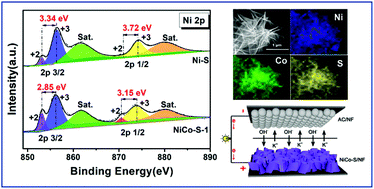Construction of self-supported hierarchical NiCo-S nanosheet arrays for supercapacitors with ultrahigh specific capacitance†
Abstract
Transition metal bimetallic sulfides derived from metal–organic frameworks (MOFs) hold great promise for energy-related applications. Here, a facile two-step MOF-engaged strategy is developed to grow ultrathin nickel–cobalt sulfide nanosheet arrays (NiCo-S) on Ni foam with robust adhesion, which provides a large specific surface area and excellent electric conductivity. The optimal self-supported NiCo-S electrode exhibits the best electrochemical performance as a binder-free electrode for supercapacitors with an ultrahigh specific capacitance of 3724 F g−1 at a current density of 1 A g−1 and maintains 1680 F g−1 at 20 A g−1, outperforming recently reported best values based on nickel–cobalt sulfides and oxide/hydroxide counterparts. The results demonstrate that the in situ growth of conductive Ni3S2, the presence of Co(OH)2 and the synergy between bimetals help contribute to the superior capacity. Most importantly, electronic and valence states are carefully investigated to reveal the synergetic effect and it is evidenced that the greatly decreased energy barrier differences between two redox pairs (Ni2+/Ni3+ and Co2+/Co3+) result in higher electrochemical performance. This work might shed light on the origin of high capacitance obtained from bimetallic compound based electrochemical energy storage devices.



 Please wait while we load your content...
Please wait while we load your content...